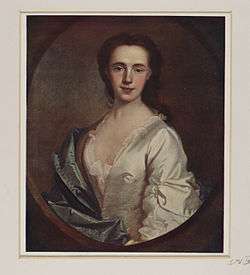Lady Anne Farquharson-MacKintosh

Lady MacKintosh (née Anne Farquharson) (1723–1784) was a Scottish Jacobite of the Clan Farquharson, a Scottish clan of the Scottish Highlands and also the wife of Angus Mackintosh, chief of the Clan Mackintosh.
Early Life
Born in 1723 to John Farquharson of Invercauld, chief of the Clan Farquharson who was a staunch Jacobite, she was married to Angus Mackintosh, chief of the Clan Mackintosh.
Jacobite rising of 1745
Early in 1744 Angus Mackintosh was offered one of three new Independent Companies being raised by John Campbell, 4th Earl of Loudoun to support the British-Hanoverian Government. Anne, dressed in male attire, rode around the glens and, in a very short time, enlisted 97 of the 100 men required for the captaincy. During the Jacobite rising of 1745, Angus' company fought for Lord Loudon's Government forces, aka. the Black Watch, in the Highlands.
When the Jacobite Prince Charles Edward Stuart landed in Scotland in 1745, Anne, then 22 years old, forcefully raised between 200 and 400 men from Clan Mackintosh and the confederation of Clan Chattan for the Prince. As women could not command in the field, the regiment was placed under the command of the chief of the Clan MacGillivray, a member of the confederation. 'Colonel' Anne's regiment joined the Prince's army at Bannockburn, near Stirling Castle, in January 1746, 12 days before the Battle of Falkirk Muir.
A month later the Prince was staying at Moy Hall, Lady Anne's home. She received a message from her mother-in-law that 1,500 of Lord Loudon's men, including her husband's company stationed 8–12 miles away at Inverness, were planning a night raid on Moy Hall to snatch the Prince (and claim the £30,000 bounty). Anne sent five of her staff out with guns to crash about and shout clan battle cries to trick the Government forces into thinking they were about to face the entire Jacobite army. The ploy worked and the Government force fled. The event became known as The Rout of Moy.
The next month her husband, who supported the Government and 300 of Loudon's men were captured north of Inverness by the Jacobites. The Prince paroled Captain Mackintosh into the custody of his wife, Lady MacKintosh, commenting "he could not be in better security, or more honourably treated". She famously greeted him with the words, "Your servant, captain" to which he replied, "your servant, colonel" thereby giving her the nickname "Colonel Anne". She was also called La Belle Rebelle (the beautiful rebel) by the Prince himself.
After the Jacobite defeat at the Battle of Culloden in April 1746, Lady M was arrested and turned over to the care of her mother-in-law for a time. She later met Prince William, Duke of Cumberland at a social event in London with her husband. He asked her to dance to a pro-Government tune and she returned the favour by asking him to dance to a Jacobite tune. She died on 2 March 1784 at Leith.
Historical Fiction
- Scottish author Janet Paisley has written a novel based on Lady MacKintosh's exploits, "White Rose Rebel", published 2007.
- Author Marsha Canham has also written an historical romance novel based on Lady MacKintosh's exploits, "Midnight Honor"; book three of a trilogy regarding the Jacobite rising preceded by "The Blood of Roses" and "The Pride of Lions".
- Portuguese author Hélia Correia has written the historical novel "Lillias Fraser", set in Scotland and Portugal between 1746 and 1762, in which Lady MacKintosh is a secondary character.
References
- ANDERSON, William, The Scottish Nation; or the Surnames, Families, Literature, Honours, and Biographical History of the People of Scotland, Vol. II of 3 volumes, A. Fullerton & Co., London, 1863. History of Clan Macintosh with detailed description of the “Rout of Moy.”
- BAIN, Robert, The Clans & Tartans of Scotland, William Collins Sons, London, 1938/1982. Source of Mackintosh war cry and plant badge.
- BARTHORP, Michael, The Jacobite Rebellions 1689-1745, Men-At-Arms Series #118, Osprey Publishing, London, 1982. Valuable source for dates and specifies that 300 of Loudon’s men surrendered at Dornoch.
- Walter Biggar Blaikie, Itinerary of Prince Charles Edward Stuart . . ., Scottish Academic Press, Edinburgh, 1975. First published 1897. Valuable source for pinning down dates and contains in postscript the report of MacDonell of Lochgarry who pursued Loudon after the “Rout of Moy” and details the surrender of Angus Macintosh.
- CRAIG, Maggie, Damn Rebel Bitches: the Women of the 45, Mainstream, 1997. A text presenting original research into the subject.
- HOOK, Michael and Ross, Walter, The ‘Forty-Five: the Last Jacobite Rebellion, The National Library of Scotland, HMSO, 1995. A brief description of the “Rout of Moy” and mentions the £30,000 reward for the capture of the Prince.
- KEAY, John & Julia, editors, Collins Encyclopaedia of Scotland, HarperCollins Publisher, London, 1994. Useful details on Lady MacKintosh and Clan Mackintosh history.
- LENMAN, Bruce, The Jacobite Clans of the Great Glen 1650-1784, Methuen London Ltd., London, 1984. Describes political considerations of Angus Macintosh in 1745 and his indecisive nature.
- LIVINGSTONE, Alastair of Bachuil, Aikman, Christian W. H. and Hart, Betty Stuart, editors, Muster Roll of Prince Charles Edward Stuart’s Army 1745-46, Aberdeen University Press, 1985. Lists the officers and men of Lady MacKintosh’s Regiment.
- McLYNN, Frank, The Jacobites, Routledge & Kegan Paul, London, 1985. Description of clan politics and feudal vs. clan society.
- MONCREIFFE, Sir Iain of that ilk, and Pottinger, Don, Scotland of Old, Clan Names Map, Bartholomew, Edinburgh, 1983. Clan map of the Scotland circa 1600.
- SCOTT-MONCRIEFF, Leslie, editor, The ‘45, to Gather an Image Whole, The Mercat Press, Edinburgh, 1988. Chapter 10 “Jacobites at Heart: An Account of the Independent Companies” by Dr. Alasdair MacLean contains Loudon’s description of the “Rout of Moy” and details of Loudon’s subsequent retreat, including contemporary quotes.